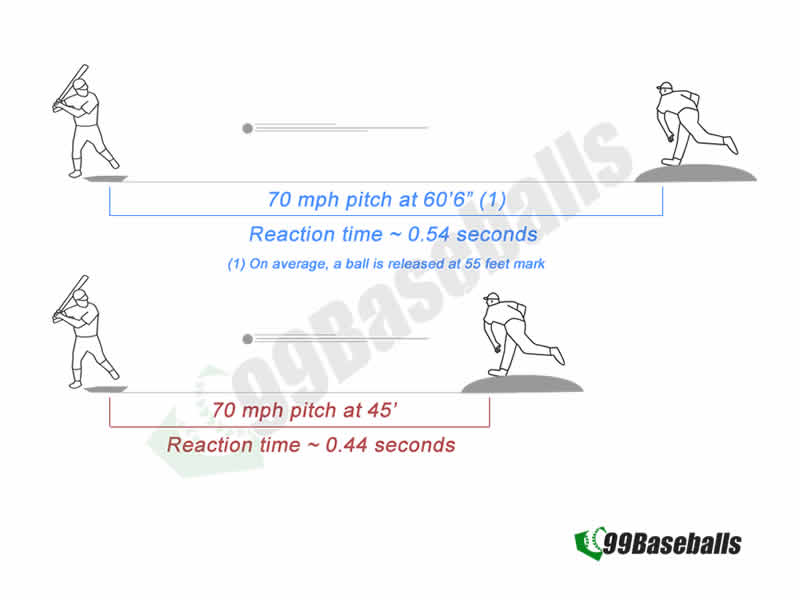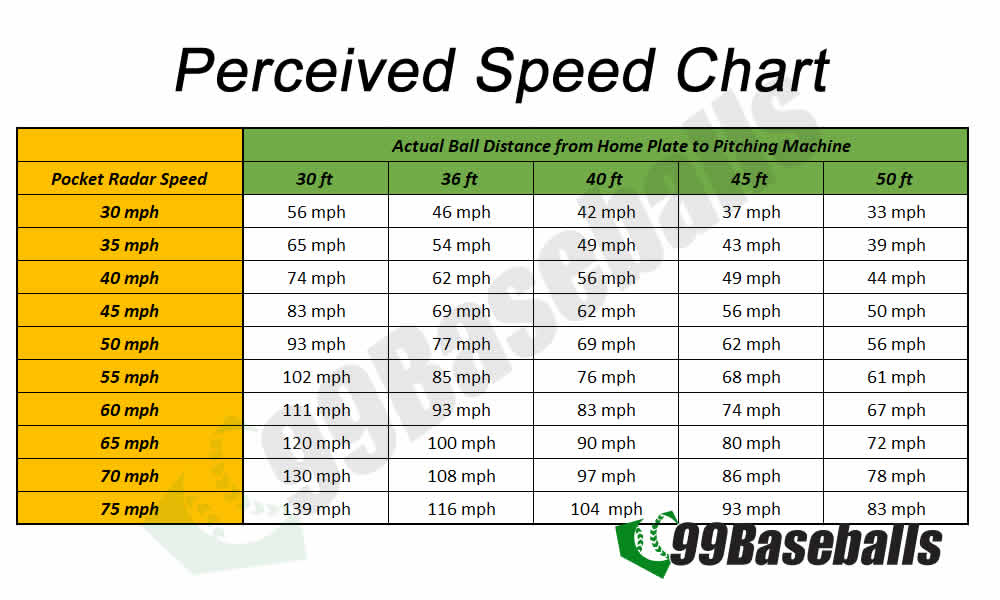
KEY TAKEAWAYS
- Baseball pitching speed from a pitching machine is the same regardless of a pitching distance
- However, a perceived pitching speed or Equivalent Reaction Time is relative to the distance
TABLE OF CONTENTS
- Introduction
- What is speed
- How can speed remain the same?
- Reaction Time
- Equivalent Speed Conversion Chart
- Summary
INTRODUCTION
It’s a common misnomer that a pitching machine throwing 70 mph from the mound on a 60×90 (distance from a home plate to pitching mound is 60′ 6″) field is faster when the same pitch is thrown from a 50×70 field (distance from a home plate to pitching mound is 50′).
This is incorrect.
If you have a speed measuring device like Pocket Radar, you can measure the speed from 60×90 and 50×70 fields to confirm that pitching speed will remain identical from both distances.
WHAT IS SPEED?
Speed is a rate at which an object’s position changes over a period of time.
The equation for speed or velocity is simple:

So if a car travels 60 miles and it takes 1 hour to complete the distance, the velocity is 60 miles / hour or 60 mph.
Another way to look at the v=s/t equation is that velocity is inversely proportional to time, assuming that the distance remains constant.
For example, if time increases in the equation, the velocity decreases and vice versa.
We can further deduce that velocity is proportional to distance, meaning if the distance increases and time remains constant, velocity will increase.
If we know two out of three variables (v, s or t), we can calculate the vale of the third variable.
If we do not possess a speed measuring device, we can simply plug in s (distance) as 60’6″ and t (time) to calculate the pitch speed.
HOW CAN SPEED REMAIN THE SAME OVER DIFFERENT DISTANCES?
Speed measuring devices like police speed guns or Pocket Radars use the doppler technology to measure speed without knowing the exact distance.
These devices measure the change in frequency of the returned radar signal caused by the Doppler effect over a pre-determined time to calculate speed. You can read more about the Doppler Effect on this Wikipedia page.
This is why measuring the rate of signal compression is one of the reasons why Pocket Radars are most accurate when speed is measured from behind a pitcher or pitching machine or behind a catcher.

REACTION TIME
Although speed will remain the same, shortened pitching distance means a batter will have less time to react to a thrown ball.
Reaction vs Reflex
- Reaction time is a measure of how quickly a person consciously respond to a stimulus
- Reflex time is an involuntary action (i.e. knee reflex test when a patellar is tapped with a rubber instrument).
A baseball thrown at 70mph from a 60×90 mound will give approximately half a second for a batter to react.
The same 70 mph from 45 feet away will reduce that reaction time down to 0.45 seconds (or 20% reduction)!

EQUIVALENT SPEED CONVERSION CHART
In order to make it easy positioning your pitching machine, I created a simple table below.

If you want to do the calculation yourself, you can either manually calculate it using the v = s/t formula or just use JavaScript calculator I found at Calculator Soup (link is in the reference section below)
SUMMARY
I hope this post was helpful as you conduct batting practice with a pitching machine.
Just keep in mind that a pitching machine does not provide a natural visual cue (i.e. pitching motion) so it is not a “true” simulation.
I know that pitching machines made for youth players max out around 70 mph so I understand that there is a need to shorten the distance to simulate faster pitches but it’s really easy to get kids demoralized.
I actually tried hitting 70 mph baseballs at 40 feet and I was terrible so please try to sensitive to batters so that they do not get discouraged!
